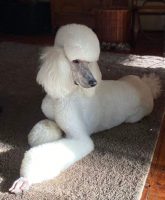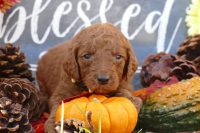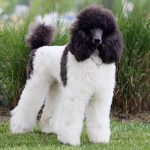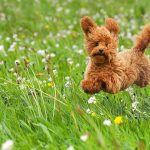 As many best-in-show winners can attest, poodles as a breed are stylish, intelligent dogs with a majestic bearing and a rich history. Poodles were originally multicolored despite efforts over time to breed the solid colors that have been most common and greatly valued in recent years. However, multicolored poodles, including harlequin poodles, are not mixed breed dogs as proven by DNA testing. They are turning heads as more unique, fabulously colored poodles are emerging. The parti poodle (parti for ‘particularly colored’) is categorized as having a dominant white coat color with spots of another color like apricot, black, brown, and grey.
As many best-in-show winners can attest, poodles as a breed are stylish, intelligent dogs with a majestic bearing and a rich history. Poodles were originally multicolored despite efforts over time to breed the solid colors that have been most common and greatly valued in recent years. However, multicolored poodles, including harlequin poodles, are not mixed breed dogs as proven by DNA testing. They are turning heads as more unique, fabulously colored poodles are emerging. The parti poodle (parti for ‘particularly colored’) is categorized as having a dominant white coat color with spots of another color like apricot, black, brown, and grey.
One variant of this is harlequin poodles, defined as strictly white with black spots or markings. Many have a mostly black head with a slender line of white from the forehead down to a small white beard. Ideally, they have two or three black spots or a black mantle (the dog’s back) which is commonly seen and a genetically dominant trait. Poodles wearing the mantle are often desirable for breeding purposes.
The pigmentation of a harlequin poodle’s skin must be light where its coat is white and darker or grey where the coat is black. The poodle’s mandibles (lower jaw) are expected to be black with darker skin pigmentation. The Harlequin poodle has dark brown eyes with nails that could be either black or white.
Breeding harlequins poodles is a delight as no two pups look alike so each litter is filled with surprises. A well-bred harlequin poodle should have clear lines between white and black with no blending. While the lines may appear blurred on a pup, this is normally resolved by the time the dog reaches adulthood. Ticking or small, irregular spots aren’t desirable in well-bred harlequins.
Breeding two parti poodles will produce a litter of all parti pups though it should be noted that the color combinations and patterns are impossible to predict. Partis paired with solid-colored poodles usually produce poodles of solid colors. Qhwn harlequins with spots, perhaps two or three, are bred, often the spots vanish, giving way to puppies with white bodies and black heads.
Contrary to popular belief, harlequins, like all parti poodles, can be AKC registered with pre-designated color numbers. While this is true, they can’t, at this time, be shown in AKC conformation events in the United States. They can be shown in obedience and agility events, however, and many enthusiasts are hopeful that one day they will be shown in conformation events in the US as they currently can in other countries.
Harlequins in miniature and medium-sized poodles have been enjoying attention in European countries like Germany for the last few years. King-sized harlequins are now being seen although with not enough frequency to be seen as anything but rare.
Harlequins, like all poodles, are a wonderful breed of dog for everyone from the beginner to the experienced enthusiast. Intelligent and friendly, poodles are perceptive, thoughtful, and responsive to the voice commands and wishes of their owners. They are good friends and good company, with great temperaments for all ages, making them ideal for families along with those who appreciate the poodle breed.
All poodles require regular maintenance to keep their coat looking beautiful. They don’t lose their hair and for people with asthma or allergies, they are an ideal breed.
Harlequins and parti poodles enjoyed a distinct popularity in the late 1900s as evidenced in paintings and photographs of the time. No written explanation is given but it would seem to the true dog lover that folks in that time knew what we are rediscovering — that harlequin poodles are not only beautiful, but bright, sweet, responsive, and ideal pets.
With their outgoing personalities and exuberance, harlequins and other poodles are highly trainable dogs. Quick learners, they ascertain patterns rapidly and are easily motivated with treats and praise from a trusted handler. Training sessions are usually enjoyable and rewarding for both dog and human.
After basic obedience has been established, harlequins can move on to more advanced disciplines including agility and trick training. Make certain they get proper exercise and have a peaceful environment, and you’ll have one of the greatest dogs you’ve ever had the privilege of befriending.







